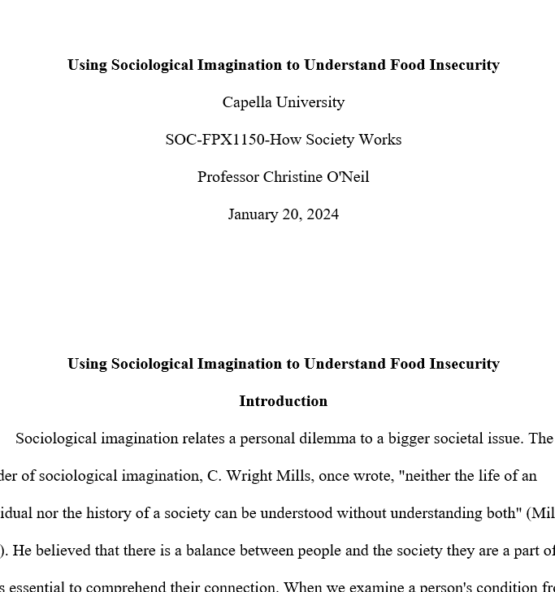


Using Sociological Imagination to Understand Food Insecurity
Capella University
SOC-FPX1150-How Society Works
Professor Christine O’Neil
January 20, 2024
Availability:In Stock
Sociological imagination relates a personal dilemma to a bigger societal issue. The founder of sociological imagination, C. Wright Mills, once wrote, “neither the life of an individual nor the history of a society can be understood without understanding both” (Mills, 1959). He believed that there is a balance between people and the society they are a part of, and it was essential to comprehend their connection. When we examine a person’s condition from a broader perspective, we may identify how society has erred and how we might try to change it. This viewpoint allows us to accomplish more than observe. We may reveal societal inequities, take action, and effect change.
I would want to study the subject of food insecurity in low-income families as a contemporary concern. According to the U.S. Department of Agriculture (2022), food insecurity exists when a household lacks consistent access to enough food to allow all members to maintain a healthy and active lifestyle. This might be a permanent or temporary circumstance for a family. The prevalence of food insecurity is a measure of people’s ability to put food on the table. In 2021, 10.2 % of American families were food insecure in 2021, with 3.8% experiencing extremely poor food security. (The U.S. Department of Agriculture, 2022). Many Americans have difficulty meeting their fundamental necessities, which raises their susceptibility to food shortages. For instance, unemployment, unanticipated car repair, or an injury might cause a household to decide between sustenance and paying their bills.
Many individuals consider the lack of food to be caused by the suffering individual, alluding to an unwillingness to work hard and alleviate the problem. They think that food-insecure families refuse to get employment, government aid, or even work on farms to grow food. However, food insecurity results from many factors beyond the individual’s control. The breakdown of our ecological, political, economic, and social systems is reflected in the prevalence of food shortages. People are hungry not because of insufficient food but because of the unfair allocation of resources (Gallegos & Chilton, 2019). Because of their social, political, and economic privileges, the powerful and wealthy also dictate how food may be obtained. Consequently, low-income individuals have fewer options for nourishing their bodies and meeting other fundamental requirements, such as having a place to live, keeping the lights on, getting a job, and having a voice in their community.
The effects of structural variables on social well-being may be shown in the case of food scarcity. When considering hunger in America from a sociological point of view, it is useful to keep in mind the ideas of sociological imagination. Going hungry is a global problem that no one person can solve. The particular condition is molded by social structure, which might limit opportunities. This may be caused by natural disasters, such as the disastrous 2004 tsunami in Asia, by human actions, such as when particular places can utilize agriculture, or by a combination of the two.
Yonah Peterson
Good